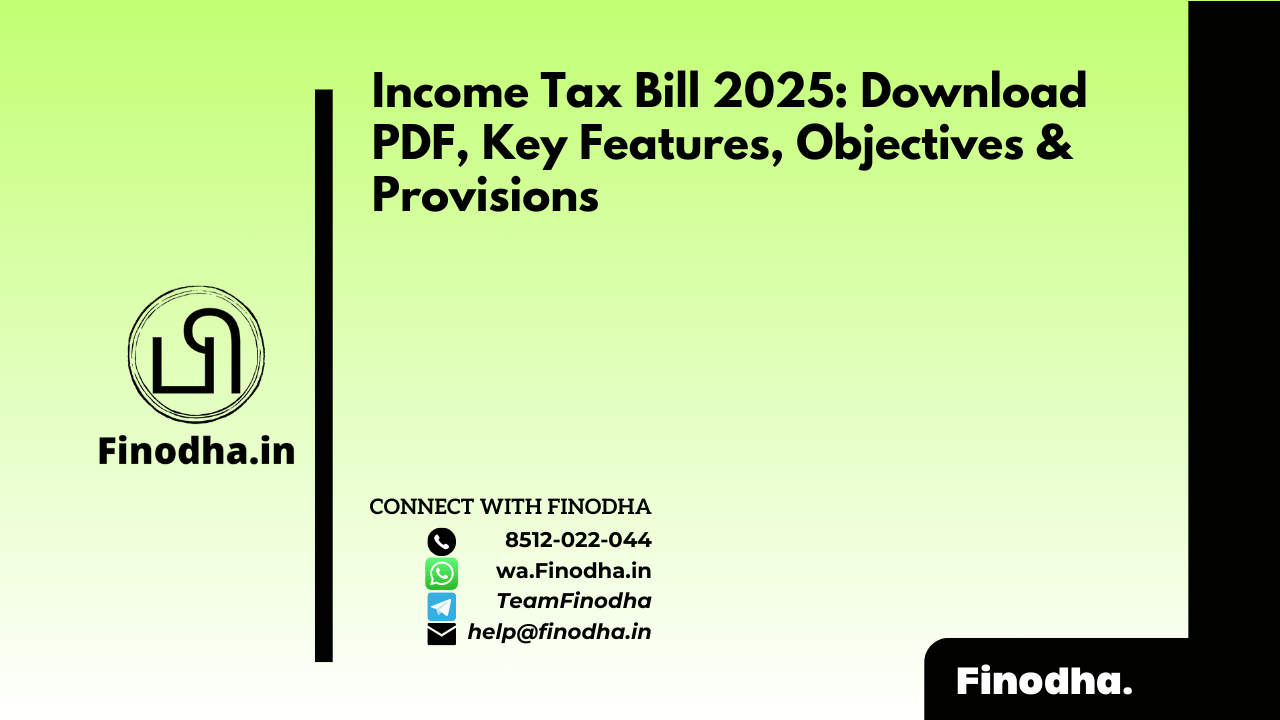Important Keyword: Due date, e-Verify ITR, File ITR, Income Tax Rates, ITR Documents, ITR Form, ITR Utility, Resident Status, Slab Rates.
Table of Contents
Income Tax: Rates, Due Date and Return Filing in India
Income tax is indeed a direct tax levied by the government on the income earned by individuals, businesses, and other entities during a financial year. In India, the Income Tax Act, 1961, along with the Income Tax Rules, 1962, governs the administration, assessment, and collection of income tax. The tax is imposed on various types of income, including salaries, business profits, capital gains, rental income, and other sources, depending on the nature of the taxpayer’s income and their tax status.
Who should file Income Tax Return (ITR)?
Filing an income tax return (ITR) is mandatory for taxpayers whose income exceeds the basic exemption limit specified by the Income Tax Act. For individuals and Hindu Undivided Families (HUFs) below the age of 60 years, the basic exemption limit for the assessment year 2019-20 was INR 2.5 lakh.
However, even if a taxpayer’s income is below the basic exemption limit, they can choose to file a NIL return. This means they are voluntarily filing a return to declare that their income is below the taxable threshold. It can be beneficial for various purposes, such as establishing a financial record, applying for loans or visas, claiming tax refunds, or fulfilling statutory requirements.
What are the Due Dates to file Income Tax Return (ITR)?
| Category | Due Date |
| Individuals to whom audit is not applicable | 31st July of the Assessment Year |
| Companies | 30th September of the Assessment Year |
| Individuals to whom audit is applicable | 30th September of the Assessment Year |
| Individuals/ HUF who are partners in a firm and firm’s accounts are subject to audit | 30th September of the Assessment Year |
Due Date for Filing ITR for AY 2021-22
What are the Documents required to file ITR?
The documents you listed are indeed essential for filing an income tax return. Let’s break it down:
- PAN (Permanent Account Number): This is a unique identification number assigned to taxpayers in India. It’s essential for various financial transactions, including filing taxes.
- Aadhar Number: Aadhar serves as a proof of identity and address and has been linked with PAN for income tax purposes.
- Form 26AS: Form 26AS is a consolidated tax statement that contains details of tax deducted on behalf of the taxpayer and tax collected during the financial year.
- Bank Account Details: This includes details of the bank accounts in which the taxpayer wants to receive any refunds.
- Challan of Advance Tax or Self-assessment Tax: If the taxpayer has paid any advance tax or self-assessment tax during the year, they need to provide details of the challan.
- Details of the Original Return (if filing a revised return): If the taxpayer is filing a revised return, they need details of the original return filed earlier.
Indeed, the specific documents required may vary based on individual circumstances and the type of income tax return form being filed. For instance, additional documents like salary slips, rent receipts, investment proofs, etc., might be required depending on the sources of income and deductions claimed.
Which ITR Form to File?
choosing the correct ITR form is crucial for accurate and efficient tax filing. Let’s briefly go over the common ITR forms for individual taxpayers:
- ITR 1 (Sahaj): This form is for resident individuals having income from salaries, one house property, other sources (excluding winnings from lottery and income from race horses), and whose total income does not exceed INR 50 lakh.
- ITR 4 (Sugam): This form is for individuals, HUFs, and firms (other than LLP) having presumptive income from business and profession. It’s also applicable for individuals who have opted for the presumptive taxation scheme under sections 44AD, 44ADA, and 44AE.
It’s important to note that other ITR forms cater to specific types of income and taxpayers:
- ITR 2: For individuals and HUFs not having income from profits and gains of business or profession.
- ITR 3: For individuals and HUFs having income from profits and gains of business or profession.
- ITR 5: For persons other than individual, HUF, company, and person filing Form ITR-7.
- ITR 6: For companies other than companies claiming exemption under section 11.
- ITR 7: For persons including companies required to furnish return under sections 139(4A) or 139(4B) or 139(4C) or 139(4D) or 139(4E) or 139(4F).
| ITR-1 (SAHAJ) | The most basic ITR form for individuals having income up to Rs. 50,00,000 from salary/pension, one house property, and interest. |
| ITR-2 | For individuals/HUF having income from salary/pension, multiple house property, capital gains, interest, and partner’s income from the partnership firm. |
| ITR-3 | For individuals/HUF having income from salary/pension, multiple house property, capital gains, interest, and income from proprietary business or profession. |
| ITR-4 | For individuals/HUF/Partnership firms having income from presumptive business or profession. |
What are the Income Tax Rates for AY 2019-20?
When it comes to paying taxes on our income, understanding the applicable rates is essential. Each year, during the Union Budget presentation by the Finance Minister, the Income Tax Slab Rates are announced for various categories of taxpayers. For individuals and Hindu Undivided Families (HUFs) below the age of 60 years, these rates determine how much tax they need to pay based on their income levels.
| Taxable Income | Tax Rate |
| Up to INR 2,50,000 | Nil |
| INR 2,50,000 to INR 5,00,000 | 5% |
| INR 5,00,000 to INR 10,00,000 | 20% |
| Above INR 10,00,000 | 30% |
Let’s delve into the current Income Tax Slab Rates for this particular category of taxpayers:
- Income up to INR 2.5 lakh: No tax (Basic Exemption Limit)
- Income from INR 2,50,001 to INR 5,00,000: 5% tax
- Income from INR 5,00,001 to INR 10,00,000: 20% tax
- Income above INR 10,00,000: 30% tax
Additionally, a cess of 4% is levied on the total tax payable by all taxpayers to support government initiatives.
How to file ITR?
To file your Income Tax Return (ITR), you have several convenient options at your disposal:
- Income Tax e-filing Website: You can directly access the Income Tax e-filing website, where you’ll find user-friendly tools to file your return electronically. Simply follow the step-by-step instructions provided on the website.
- Income Tax Account: If you have an income tax account, you can log in and file your return seamlessly. Ensure you have all the necessary documents and details ready before initiating the process.
- IT Utilities: The Income Tax Department provides various utilities to assist taxpayers in filing their returns accurately. These utilities are designed to simplify the process and help you complete your return efficiently.
- ERI (e-Return Intermediary): Government-approved intermediaries like Finodha.in offer services to facilitate e-filing of tax returns. These platforms provide additional support and guidance throughout the filing process, ensuring compliance with tax regulations.
Choose the method that best suits your preferences and requirements, ensuring timely and accurate filing of your Income Tax Return.
e-File ITR using Income Tax e-Filing Website
To file your Income Tax Return (ITR) through the income tax e-filing website, you’ll need to access your e-Filing account. Here’s a step-by-step guide to help you through the process:
- Login: Visit the e-Filing portal and enter your user ID (PAN), password, and captcha code. Then, click on ‘Login’ to access your account.
- Navigate to e-File: Once logged in, go to the ‘e-File’ section and select ‘Income Tax Return’.
- Select ITR Form and Assessment Year: Choose the appropriate ITR Form and Assessment Year based on your income sources and the relevant financial year.
- Prepare Your ITR: Fill in all the required details in the selected ITR Form. Provide accurate information to ensure the correctness of your return.
- Pay Self-Assessment Tax or Claim Refund: If you have any outstanding tax dues, pay them as self-assessment tax. Alternatively, if you’ve paid excess tax during the financial year, claim a tax refund.
- Submit Your ITR: After filling in all the details and verifying the information, click on ‘Submit’ to file your ITR electronically.
If you prefer to prepare your ITR offline, you can use Income Tax Utilities provided by the department. Here’s how to do it:
- Download Utilities: Visit incometaxindiaefiling.gov.in and click on ‘Offline Utilities’ under the Download section. Then, navigate to ‘Income Tax Return Preparation Utilities’ and select the assessment year.
- Download ITR Utility: Choose the required ITR Form and download the corresponding utility for that form.
- Extract and Prepare ITR: Extract the files from the downloaded zip folder and use the utility to prepare your ITR offline.
- Upload Utility: Once your ITR is ready offline, upload the utility to your Income Tax e-filing account for submission.
By following these steps, you can either e-file your ITR directly through the income tax e-filing website or prepare it offline using Income Tax Utilities and then upload it to your e-filing account.
What is ITR e-Verification?
Completing the ITR filing process involves e-verifying your return. Once you file your ITR, you’ll receive an ITR-V, also known as the Income Tax Return Verification Form, on your registered email ID from the income tax department.
Here are the methods you can use to e-verify your ITR:
- Aadhaar OTP: Use the Aadhaar OTP option for verification. You’ll receive a One-Time Password (OTP) on your registered mobile number linked with Aadhaar. Enter this OTP to verify your return.
- Bank ATM: Visit an ATM of your bank and select the option for e-verification of income tax return. Follow the instructions on the screen to complete the process.
- Net Banking Option: Log in to your bank’s net banking portal and look for the option to e-verify your income tax return. Follow the steps provided to complete the verification.
- Bank Account Option: You can e-verify your return using your bank account details. The income tax department verifies your return electronically based on the information provided.
- Demat Account Option: If you have a Demat account, you can use it to e-verify your ITR. Follow the instructions provided by the income tax department for e-verification using a Demat account.
- Physically sending ITR-V: If you prefer the traditional method, you can download the ITR-V from your income tax account and send it physically to the income tax department’s CPC office within the specified time frame. Ensure that you send it via ordinary post or speed post only.
Read More: Accept Appointment and Filing for Tax Audit Report
Web Stories: Accept Appointment and Filing for Tax Audit Report
Official Income Tax Return filing website: https://incometaxindia.gov.in/




